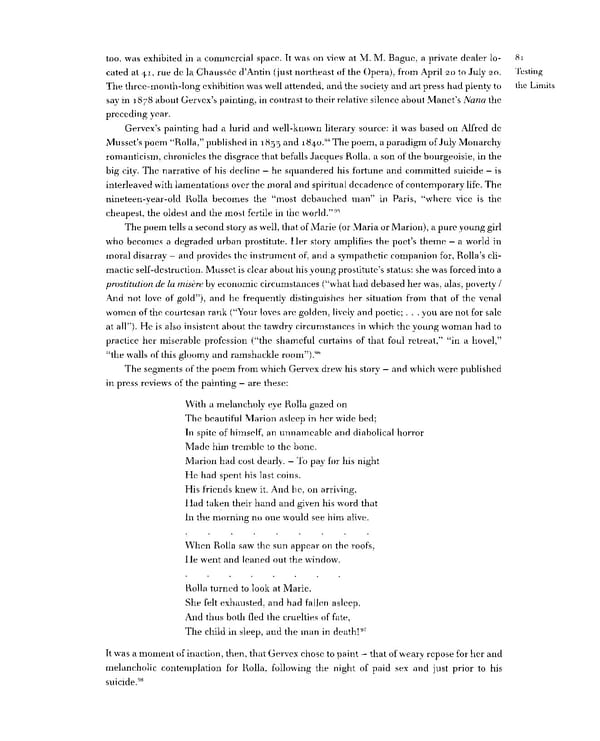too, was exhibited in a commercial space. It was on view at M. M. Bague, a private dealer lo- 81 cated at 41, rue de la Chaussee d'Antin (just northeast of the Opera), from April 20 to July 20. Testing The three-month-long exhibition was well attended, and the society and art press had plenty to the Limits say in 1878 about Gervex's painting, in contrast to their relative silence about Manet's Nana the preceding year. Gervex's painting had a lurid and well-known literary source: it was based on Alfred de 94 Musset's poem "Rolla," published in 1833 and i840. The poem, a paradigm of July Monarchy romanticism, chronicles the disgrace that befalls Jacques Rolla, a son of the bourgeoisie, in the big city. The narrative of his decline — he squandered his fortune and committed suicide — is interleaved with lamentations over the moral and spiritual decadence of contemporary life. The nineteen-year-old Rolla becomes the "most debauched man" in Paris, "where vice is the cheapest, the oldest and the most fertile in the world."95 The poem tells a second story as well, that of Marie (or Maria or Marion), a pure young girl who becomes a degraded urban prostitute. Her story amplifies the poet's theme — a world in moral disarray - and provides the instrument of, and a sympathetic companion for, Rolla's cli- mactic self-destruction. Musset is clear about his young prostitute's status: she was forced into a prostitution de la misere by economic circumstances ("what had debased her was, alas, poverty / And not love of gold"), and he frequently distinguishes her situation from that of the venal women of the courtesan rank ("Your loves are golden, lively and poetic; . . . you are not for sale at all"). He is also insistent about the tawdry circumstances in which the young woman had to practice her miserable profession ("the shameful curtains of that foul retreat," "in a hovel," "the walls of this gloomy and ramshackle room").96 The segments of the poem from which Gervex drew his story — and which were published in press reviews of the painting — are these: With a melancholy eye Rolla gazed on The beautiful Marion asleep in her wide bed; In spite of himself, an unnameable and diabolical horror Made him tremble to the bone. Marion had cost dearly. — To pay for his night He had spent his last coins. His friends knew it. And he, on arriving, Had taken their hand and given his word that In the morning no one would see him alive. When Rolla saw the sun appear on the roofs, He went and leaned out the window. Rolla turned to look at Marie. She felt exhausted, and had fallen asleep. And thus both fled the cruelties of fate, 97 The child in sleep, and the man in death! It was a moment of inaction, then, that Gervex chose to paint - that of weary repose for her and melancholic contemplation for Rolla, following the night of paid sex and just prior to his 98 suicide.
 Prostitution & Impressionists Page 101 Page 103
Prostitution & Impressionists Page 101 Page 103